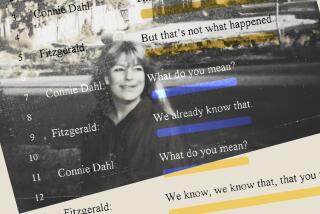NBC’s ‘Love, Lies’ Opens Old Wounds : Television: The network’s dramatization of the Orange County murder case got good marks for fairness, but for some involved in the case, it was too hard to watch.
- Share via
NBC may have wooed millions of viewers around the country Sunday and Monday nights with its lavish production about Orange County murderer David Arnold Brown and the ultimate dysfunctional family, but some of those most familiar with the tale wanted nothing to do with it.
“I couldn’t watch it,” said Ethel Bailey, the 60-year-old mother of two of the main characters in “Love, Lies and Murder”--the murder victim and the sister who helped kill her. “I want to watch it later on tape, but right now it’s just too tough.
“Can anyone understand what it’s like to have a death in the family and then have it publicized all over the television and have to relive the whole thing again?” the Victorville woman asked angrily. “All the wounds are reopened.”
The movie begins with the 1985 shooting death of Ethel Bailey’s daughter, Linda Brown, in her Garden Grove bed at the hands of Linda’s 14-year-old stepdaughter. From there, it traces the discovery that the entire plot had been orchestrated by David Brown, the murder victim’s husband, with the aid of the victim’s own 17-year-old sister.
With a few strong exceptions, many of the family members, lawyers and law enforcement officials familiar with the Brown story gave the movie good marks for a reasonably fair presentation of the case. But Ethel Bailey wasn’t alone in shunning it altogether.
“I didn’t watch any of it,” said 71-year-old Arthur Brown of Carson, the father of David Brown and the man portrayed in the movie as having helped prod his granddaughter into revealing that she had not acted alone in the killing.
“It’s all just a bunch of bull as far as I’m concerned,” the elder Brown added. “I still love (David) and I believe he’s innocent. That’s all there is to it.”
David Brown’s older brother Tom didn’t watch the movie either--but for very different reasons. Investigators said David Brown used Tom early in 1989 as an unwitting dupe in an effort to kill three key figures in his prosecution, and Tom said he wants to have nothing to do with the man or the case anymore.
Even Donald Rubright, an attorney involved in the case who had assisted in the filming of some court scenes, said: “To tell you the truth, I fell asleep and went to bed around 10 o’clock.”
One person who watched the movie with a close eye was Ann Rule, a true-crime writer in Seattle who has scored best-sellers with past works on Ted Bundy and others. Her own book on the Brown case is due early in May.
While the movie included some liberal embellishment of chronologies and dialogue, the main fault found by such critics as Rule and the prosecutor in the case, Orange County Deputy Dist. Atty. Jeoffrey Robinson, was in its portrayal of the victim’s sister.
The movie gives a generally sympathetic depiction of Patti Bailey, 17 at the time of the murder, as a manipulated teen-ager who was forced to have an affair with her brother-in-law and who then helps kill her sister.
But Rule and Robinson say the movie was slanted in Bailey’s favor since she was the scriptwriters’ main source. (In exchange for her cooperation, a substantial trust fund was set up for Bailey’s infant daughter, fathered by David Brown.) Rule and Robinson maintain that Bailey was a willing participant, profiting from the murder when she married Brown and enjoyed the upscale lifestyle afforded by the victim’s $835,000 in life insurance policies.
More to Read
The complete guide to home viewing
Get Screen Gab for everything about the TV shows and streaming movies everyone’s talking about.
You may occasionally receive promotional content from the Los Angeles Times.






